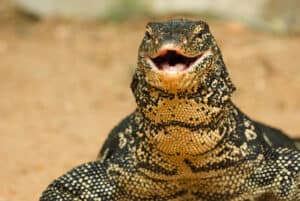Known for their bright colors and dragon-esque faces, iguanas are mainstays in many tropical places. Although generally harmless to humans, these reptiles can also be a nuisance, often finding their way into homes and hiding under or on furniture. Below, we’ve listed the seven biggest iguana genera (and the individual species containing the largest specimen) based on measurements from the tip of the head to the end of the tail. Take a look at this preview:
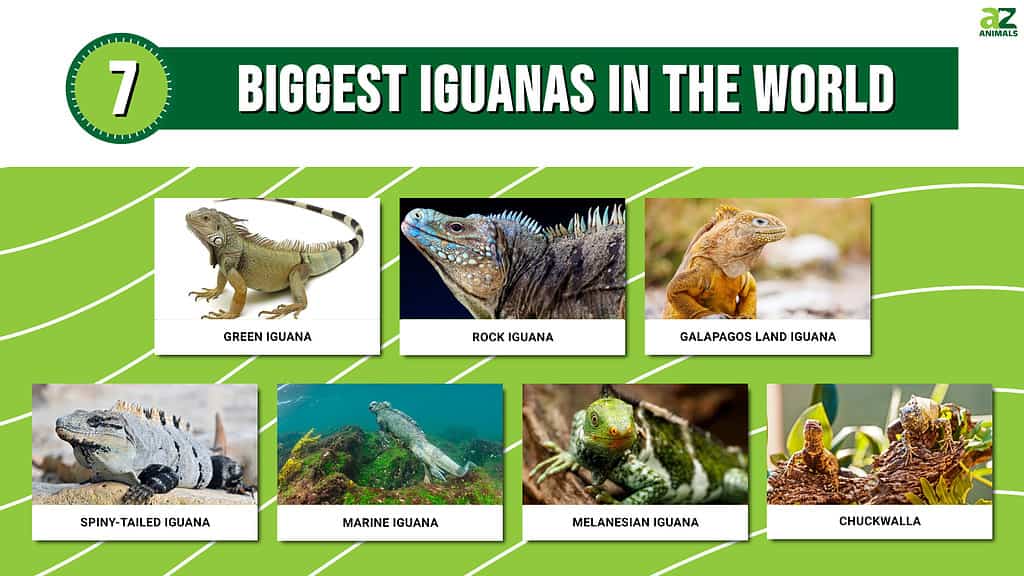
Now read on to learn more information about these fascinating iguanas, where they live, and how big they are!
7. Chuckwalla (sauromalus)

The chuckwalla lives mostly in the southwestern United States and Mexico.
©iStock.com/adogslifephoto
- 5 species
- Largest: San Esteban chuckwalla
- Measures: (2.5 ft.) 76 cm.
These desert iguanas look like smaller Komodo dragons with loose folds of tough skin covered in small scales. They are stocky, wide-bodied, and can be reddish-pink, orange, yellow, or light gray in color. There are five extant species of chuckwallas in the southwestern US and Mexico, with some endemic to certain islands like the Angel Island and Santa Catalina chuckwallas. Chuckwallas prefer warm, dry environments, lava flows, and rocky areas. These iguanas are primarily herbivores, feeding on leaves, fruit, and flowers but have been known to eat insects to supplement their diets on occasion. Chuckwallas even hibernate during the colder months of the year, unlike many of their tropical kin. The name “chuckwalla” is Native American in origin. It was transcribed from Shoshone to Spanish as “chacahuala.”
6. Melanesian Iguana (brachylophus)

The Fiji crested iguana, which lives in the Southwest Pacific, is critically endangered.
©iStock.com/Donyanedomam
- 4 species
- Largest is the Fiji crested iguana
- Measures: (2.6 ft.) 80 cm.
Similar in size to chuckwallas, Melanesian iguanas consist of four separate species, with the Fiji crested iguana coming in as the largest. Melanesian iguanas are almost all listed as critically endangered by the IUCN, with many populations limited to one or two islands in the southwest Pacific. Since 2008, multiple iguana species recovery plans have been implemented in Fiji to varying degrees of success. Increased funding has allowed scientists to get a better understanding of existing threats and population numbers, but many goals of the recovery plan remain incomplete.
The Greek name for the Melanesian iguana genus is brachylophus; “brachys” means short, and “lophos” means crest or plume, referencing the spiny crests found on the iguanas. They appear in a variety of greens and are some of the most geographically isolated species of iguana found in the world. Competing theories exist over how they even managed to make it to the Fijian Archipelago, although there is some consensus around the idea that they rafted across the Pacific Ocean with the aid of a strong South Equatorial Current. Four months and thousands of miles at sea seems pretty far-fetched for an iguana, but the ancestors of the current species could have had adaptions like different food requirements and a long egg incubation period.
5. Marine Iguana (Amblyrhynchus)
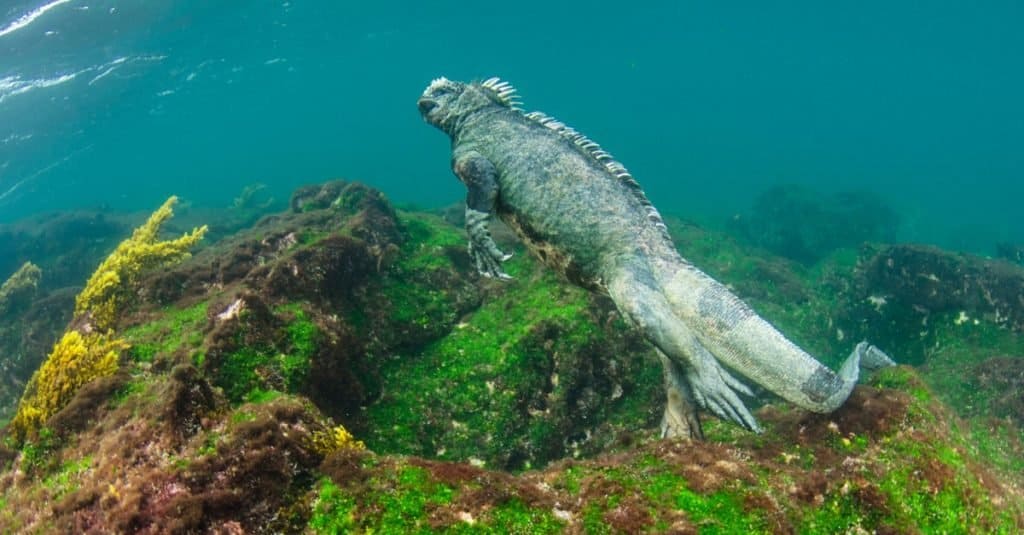
The Marine Iguana as seen underwater off Fernandina Island, Galapagos Islands, Ecuador.
©Danita Delimont/Shutterstock.com
- 1 species
- Measures: (3.9 ft.) 119 cm
Marine iguanas are the only known lizards to spend considerable time in the ocean. They are proficient swimmers and capable of diving to a depth of 65 feet. The iguanas swim to satisfy a highly specialized diet of marine algae that grows underwater and along rocky shores. Even though they feed in the water, marine iguanas spend most of their time on land and can often be observed sunning themselves. Marine iguanas are also known for their salt glands, which they use to expel salt from the large amount they ingest while consuming food underwater.
Marine iguanas are endemic to the Galapagos Islands, and while there are a few identified subspecies, marine iguanas are the only official species in the genus Amblyrhynchus. They have a thickset body with short, powerful limbs and a flat tail which helps them swim. Marine iguanas often appear black and gray, which allows their body to rapidly absorb heat after taking a cold swim. Despite conservation protections and locally abundant numbers, marine iguanas are highly dependent on algal growth, which varies from year to year. The IUCN lists them as vulnerable.
4. Spiny-Tailed Iguana (Ctenosaura)
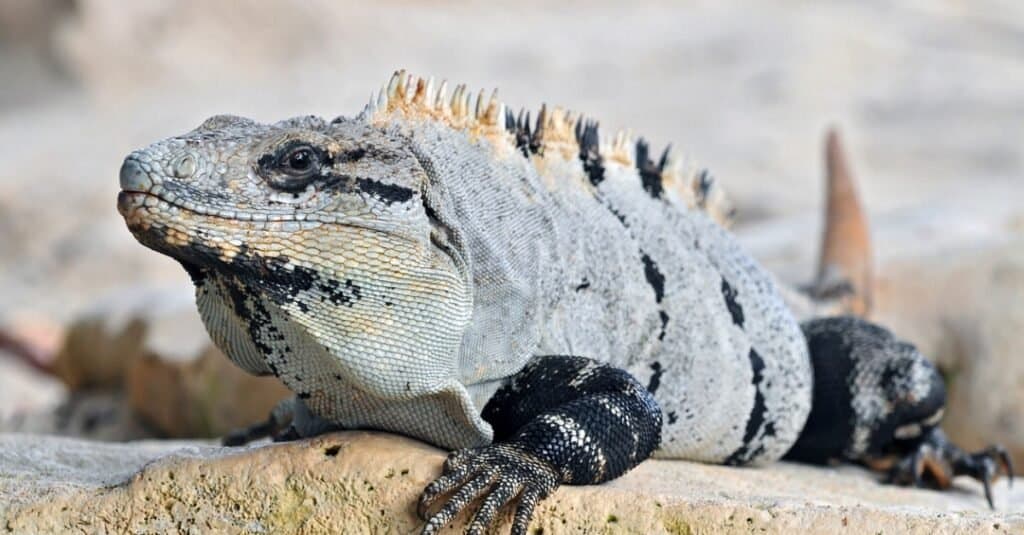
A Mexican spiny-tailed iguana can grow to lengths surpassing 4 feet.
©iStock.com/Cezary Wojtkowski
- 15 species
- Largest: Mexican spiny-tailed
- Measures: (4 ft. 7-in.) 139.7 cm.
Right in the middle of our list, the spiny-tailed iguanas encompass at least 15 recognized species. They are a larger group native to Mexico and Central America and have enlarged, spiny scales on their tails. Unlike some of the iguanas listed above, the spiny-tailed group is omnivorous, eating small fruits, flowers, and small animals. Spiny-tailed iguanas inhabit dry forests below ~3,900 ft. (1200 m) in elevation on the coast.
Able to grow to more than four and a half feet in length, the Mexican spiny-tailed is the largest species of the group. Another member of the genus, the Costa Rican spiny-tailed, previously held the Guinness world record for fastest lizard (21.5 mph). It has since been surpassed by the green iguana (22 mph) and the perentie, which is a type of monitor lizard that can reach speeds of 25 mph.
3. Galapagos Land Iguana (Conolophus)
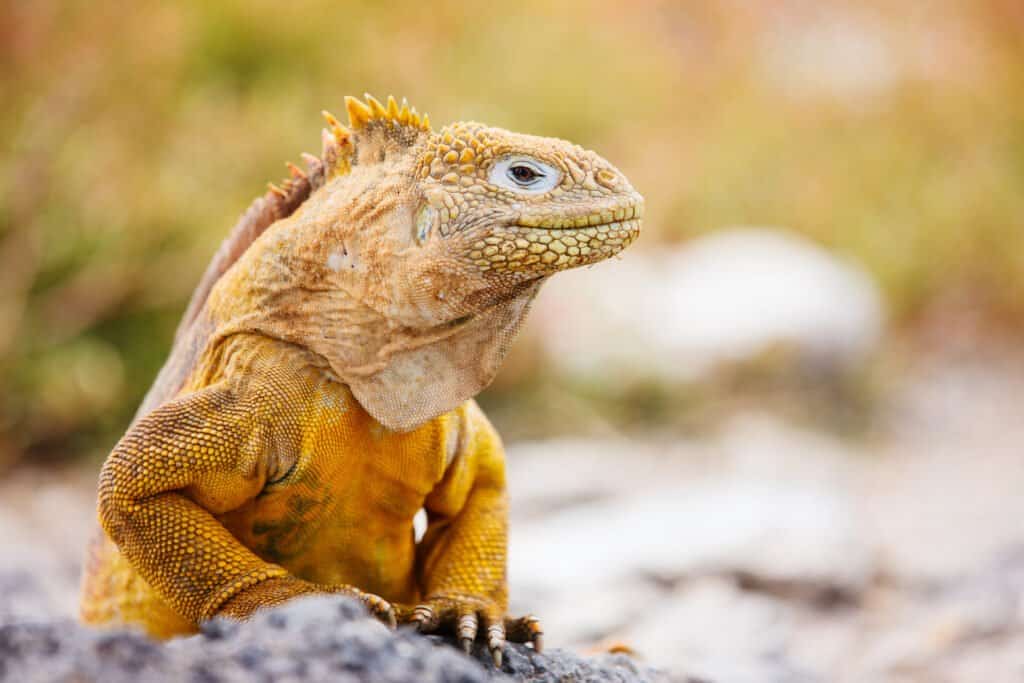
A Galapagos land iguana is slightly larger than its marine peers.
©BlueOrange Studio/Shutterstock.com
- 3 species
- Largest: Galapagos Land Iguana
- Measures: (5 ft.) 152.4 cm.
The Galapagos land iguana takes third place with a maximum length of nearly five feet. Like the marine iguanas, all three species in the genus are endemic to the Galapagos Islands, and their conservation status ranges from vulnerable (Galapagos land iguana and Santa Fe land iguana) to critically endangered (Galapagos pink land iguana). The Galapagos pink land iguana is particularly interesting due to its unusual pink color and limited habitat (only found on the slopes of one volcano on one island); scientists estimate there are only 200 left in the wild.
There is a bit of controversy around the Galapagos land iguana and the Santa Fe land iguana, with doubt being cast over whether they are two distinct species. They are quite similar, but the Santa Fe is more of a paler yellow, has a long, tapered snout and more obvious dorsal spines. One of the more interesting things to note about land iguanas is their symbiotic relationship with island finches. The finches remove parasites and ticks from the iguana, providing relief to the lizard and easy food for the birds.
2. Rock Iguana (Cyclura)
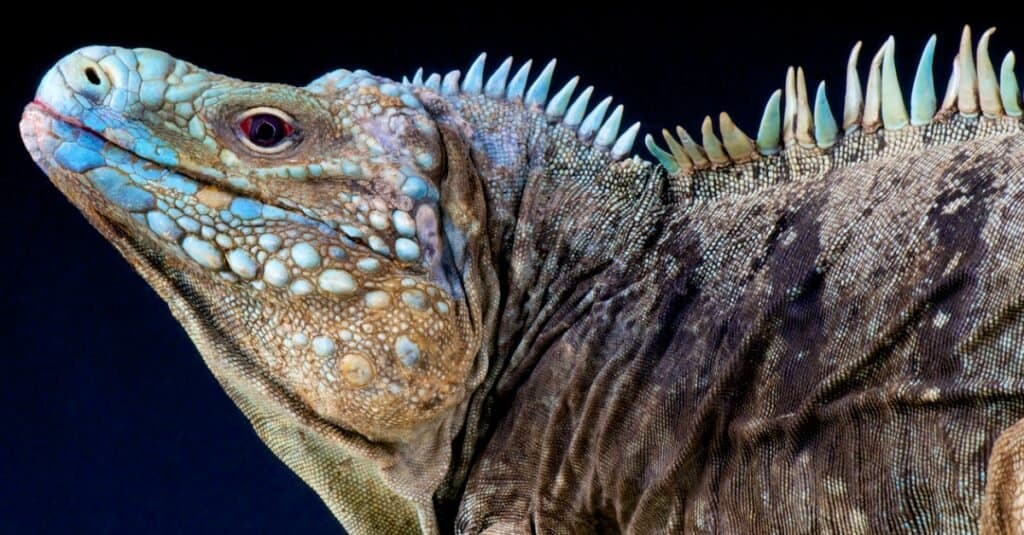
The blue rock iguana is one of the. most endangered iguana species in the world.
©iStock.com/reptiles4all
- 10 species
- Largest: Cuban Rock Iguana
- Measures: (5 ft. 2 in.) ~157 cm.
Found on islands in the West Indies, rock iguanas encompass a large group of species and subspecies noted for their longevity. One blue iguana was thought to be 69 years old at the time of its death, which would make it the world’s longest-living recorded lizard (at least 54 of those years were spent in captivity). The current record for longest captive-born rock iguana is 41 years and belongs to a rhinoceros iguana named Rhino who lives at the Australia Zoo.
Rock iguanas prefer dry forested areas with eroded limestone and sparse vegetation, dining mainly on herbivorous treats like leaves, flowers, and berries. Size varies with each species, but the largest rock iguana measured was 5.2 feet long. Of the ten recognized species, two are vulnerable, four are endangered, and four are critically endangered.
1. Green Iguana (Iguana iguana)
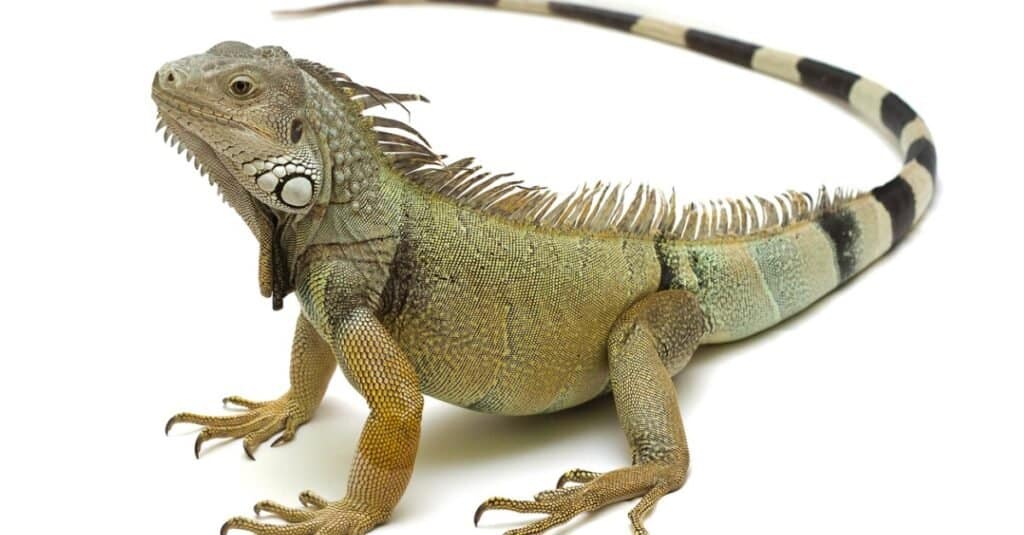
The green iguana is the largest iguana species on Earth!
©iStock.com/Che_Tina_Plant
- 2 species
- Largest: Green iguana
- Measures: (6.6 ft.)
The green iguana is the biggest iguana species on Earth! It is also the only species to be listed as Least Concern by the IUCN regarding its conservation status. These guys are everywhere, from Brazil to Mexico to Florida. Colloquially known as the “chicken of the trees,” in Puerto Rico, green iguanas are the most likely iguana to be a pet. The genus contains two species, the Lesser Antillean iguana and the larger green iguana. The average size for a green iguana is nearly five feet, although a few have grown to over six and a half feet long!
Like many on this list, green iguanas are primarily herbivores. They are also agile tree climbers and proficient burrowers. In some areas of their massive range, they are eaten and may be more endangered than others, but by in large, the species is stable. They are considered an invasive species in several locations, most notably Hawaii and Florida, where they are responsible for much ecological damage. One of the stranger events involving the green iguana occurred in Florida in 2008, 2010, 2018, and 2020, when strong cold fronts plummeted local temperatures. The iguanas entered into a torpor (like hibernation) and lost control of their grips on branches, dropping from trees as if it was raining iguanas. When temperatures moderated, most iguanas were able to pick themselves up and continue existing.
Summary Of The 7 Biggest Iguanas In The World
| Rank | Iguana | Size | Found In |
|---|---|---|---|
| 7 | Chuckwallas (sauromalus) | 2.5 feet | Southwestern US and Mexico |
| 6 | Melanesian Iguanas (brachylophus) | 2.6 feet | Southwest Pacific |
| 5 | Marine Iguanas (Amblyrhynchus) | 3.9 feet | Galapagos Islands |
| 4 | Spiny-Tailed Iguana (Ctenosaura) | 4 feet, 7 inches | Mexico and Central America |
| 3 | Galapagos Land Iguanas (Conolophus) | 5 feet | Galapagos Islands |
| 2 | Rock Iguanas (Cyclura) | 5 feet, 2 inches | West Indies |
| 1 | Green Iguanas (Iguana iguana) | 6 feet, 6 inches | North, Central, and South Americas, and the Eastern Caribbean |
The photo featured at the top of this post is © iStock.com/reptiles4all
Thank you for reading! Have some feedback for us? Contact the AZ Animals editorial team.




